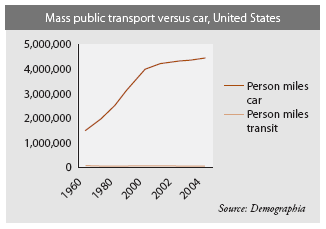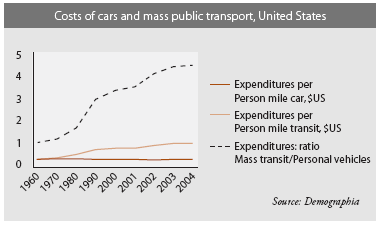When US journalist Lincoln Steffens returned from Russia in 1921, he famously declared “I have seen the future and it works”. As we now know, the future that did actually work was not the socialism he admired but free enterprise and consumer sovereignty. Transport and urban planning generally is the last redoubt of the socialism much admired by yesteryears’ elites.
As to what actually works in the future, then and today, this is best observed in the US itself. In the case of urban change and the transport needs this brings, the US remains the best guide, in part because it tends to have multiple jurisdictions that both learn from each other and are somewhat in competition. If one city departs from allowing genuine consumer needs to be fulfilled, it faces competition from others that are more responsive to the needs of consumers, workers and commerce.
The pattern of transport in the US reveals a sharply declining share of public transport within the overall transport market. In terms of car versus transit, the following illustrates this. Since the 1960s, mass transit has dropped from a previously minuscule 3 per cent share to 1 per cent of the market. The dramatic loss of business by transit is reflected in its increased costs. Notwithstanding energy crises and taxes, the cost of moving people by transit, relative to cars, has vastly increased.
Advertisement
Back in 1960, both modes cost about the same at a little over 20 cents per person mile. Car travel has remained at about that level but transit costs have risen to 95 cents per person mile - four-and-a-half times the cost of car travel.

Trends in Melbourne
Melbourne has shown comparable trends. Data on the Demographia site show that Melbourne is one of only three cities from 100 around the world with recently increased shares for transit (in all three cases the increases were minuscule).

But over the past half century, public transport as a share of passenger trips in Melbourne has fallen from 57 per cent to about 8 per cent. In the process, public transport has moved from turning a modest profit to being subsidised to the tune of about 80 per cent of overall costs.
The Government says it is to roll back this long-term trend of patronage loss by public transport. It wants to see public transport providing 20 per cent of all motorised trips by 2020.
Advertisement
Melbourne 2030’s ambitious goal for shifting mode choice across the metropolitan area between 1995 and 2020 involves the following:
- car use is intended to decrease from 74 per cent of all trips to roughly 60 per cent;
- public transport use is intended to increase from 7 per cent of all trips to roughly 15 per cent; and
- walking and cycling are intended to increase from 19 per cent of all trips to roughly 25 per cent.
Such a reversal of previous trends would be unprecedented in any country in the world. Even icon cities such as Portland, which have implemented tough anti-parking restraints and spent a fortune on light rail, have seen transit patronage grow by less than a percentage point.
Discuss in our Forums
See what other readers are saying about this article!
Click here to read & post comments.
91 posts so far.